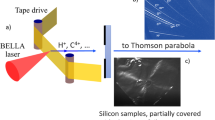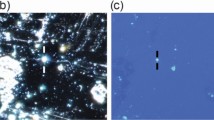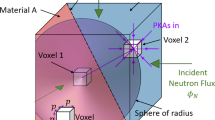Abstract
We present findings on the structure, energies and behaviour of defects in irradiated graphitic carbon materials. Defect production due to high-energy nuclear radiations experienced in graphite moderators is generally associated with undesirable changes in internal energy, microstructure and physical properties—the so-called Wigner effect. On the flip side, the controlled introduction and ability to handle such defects in the electron beam is considered a desirable way to engineer the properties of carbon nanostructures. In both cases, the atomic-level details of structure and interaction are only just beginning to be understood. Here, using a model system of crystalline graphite, we show from first-principles calculations, new details in the behaviour of vacancy and interstitial defects. We identify a prominent barrier-state to energy release, reveal a surprising ability of vacancy defects to bridge the widely spaced atomic layers, and discuss physical property and microstructure changes during irradiation, including interactions with dislocations.
This is a preview of subscription content, access via your institution
Access options
Subscribe to this journal
Receive 12 print issues and online access
$259.00 per year
only $21.58 per issue
Buy this article
- Purchase on Springer Link
- Instant access to full article PDF
Prices may be subject to local taxes which are calculated during checkout





Similar content being viewed by others
References
Simmons, J.H.W. Radiation Damage in Graphite (Pergamon, London, 1965).
Arnold, L. Windscale 1957: Anatomy of a Nuclear Accident (Palgrave Macmillan, London, 1995).
Banhart, F. Irradiation effects in carbon nanostructures. Rep. Prog. Phys. 62, 1181–1221 (1999).
Thrower, P.A. The study of defects in graphite by transmission electron microscopy. Chem. Phys. Carbon 5, 217–319 (1969).
Kelly, B.T. The Physics of Graphite (Applied Science, London, 1981).
Kelly, B.T., Marsden, B.J. & Hall, K. Irradiation Damage in Graphite due to Fast Neutrons in Fission and Fusion Systems TECDOC-1154. (International Atomic Energy Agency, Vienna, Austria). Available online at http://www.iaea.org
Iwata, T. Fine structure of Wigner energy release spectrum in neutron-irradiated graphite. J. Nucl. Mater. 133–134, 361–364 (1985).
Coulson, C.A. & Poole, M.D. Calculations of the formation energy of vacancies in graphite crystals. Carbon 2, 275–279 (1964).
Thrower, P.A. & Loader, R.T. Interstitial atom energies in graphite. Carbon 7, 467–477 (1969).
Nicholson, A.P.P. & Bacon, D.J. A defect molecule calculation for the vacancy in graphite. Carbon 13, 275–282 (1975).
Zunger, A. & Englman, R. Self-consistent LCAO calculation of the electronic properties of graphite. II. Point vacancy in the two-dimensional crystal. Phys. Rev. B. 17, 642–661 (1978).
Abrahamson, J. & Maclagan, G.A.R. Theoretical studies of interstitials in graphite. Carbon 22, 291–295 (1984).
Kaxiras, E. & Pandey, K.C. Energetics of defects and diffusion mechanisms in graphite. Phys. Rev. Lett. 61, 2693–2696 (1988).
Xu, C.H., Fu, C.L. & Pedraza, D.F. Simulations of point-defect properties in graphite by a tight-binding-force model. Phys. Rev. B 48, 13273–13279 (1993).
Nordlund, K., Keinomen, J. & Mattila, T. Formation of ion irradiation induced small-scale defects on graphite surfaces. Phys. Rev. Lett. 77, 699–702 (1996).
Hjort, M. & Stafström, S. Modeling vacancies in graphite via the Hückel method. Phys. Rev. B 61, 14089–14094 (2000).
Salonen, E., Krasheninnikov, A.V. & Nordlund, K. Ion-irradiation-induced defects in bundles of carbon nanotubes. Nucl. Instrum. Meth. B 193, 603–608 (2002).
Iwata, T., Nihira, T. & Matsuo, H. Irradiation and annealing effects on the c-axis electrical resistivity of graphite. J. Phys. Soc. Japan 36, 123–129 (1974).
Coutinho, J., Jones, R., Briddon, P.R. & Öberg, S. Oxygen and dioxygen centers in Si and Ge: Density-functional calculations. Phys. Rev. B 62, 10824–10840 (2000).
Payne, M.C., Teter, M.P., Allan, D.C., Aria, T.A. & Joannopoulos, J.D. Iterative minimization techniques for ab initio total-energy calculations: molecular dynamics and conjugate gradients. Rev. Mod. Phys. 64, 1045–1097 (1992).
Kelly, K.F. & Halas, N.J. Determination of a and b site defects on graphite using C60-adsorbed STM tips. Surf. Sci. 416, L1085–L1089 (1998).
Thrower, P.A. & Mayer, R.M. Point defects and self-diffusion in graphite. Phys. Status Solidi A 47, 11–37 (1978).
Asari, E., Kitajima, M., Nakamura, K.G. & Kawabe, T. Thermal relaxation of ion-irradiation damage in grapite. Phys. Rev. B. 47, 11143–11148 (1993).
Hinman, G.W., Haubold, A., Gardner, J.O. & Layton, J.K. Vacancies and interstitial clusters in irradiated graphite. Carbon 8, 341–351 (1970).
Heggie, M. et al. LDF calculations of point defects in graphites and fullerenes. Electrochem. Soc. Proc. 98–8, 60–67 (1997).
Mitchell, E.W.J. & Taylor M.R. Mechanism of stored-energy release at 200 °C in electron-irradiated graphite. Nature 208, 638–641 (1965).
Grennal, A. Direct observations of dislocations in graphite. Nature 182, 448–450 (1958).
Joós, B. & Duesbery, M.S. The Peierls stress of dislocations: An analytic formula. Phys. Rev. Lett. 78, 266–269 (1997).
Xhie, J., Sattler, K., Ge, M. & Venkateswaran, N. Giant and supergiant lattices on graphite. Phys. Rev. B. 47, 15835–15841 (1993).
Rong, Z.Y. Extended modifications of electronic structures caused by defects: Scanning tunneling microscopy of graphite. Phys. Rev. B 50, 1839–1843 (1994).
Terrones, M., Terrones, H., Charlier, J.C., Banhart, F. & Ajayan, P.M. Coalescence of single-walled carbon nanotubes. Science 288, 1226–1229 (2000).
Terrones, M. et al. Molecular junctions by joining single-walled carbon nanotubes. Phys. Rev. Lett. 89, 75505 (2002).
Yu, M.F. et al. Strength and breaking mechanism of multiwalled carbon nanotubes under tensile load. Science 287, 637–640 (2000).
Esquinazi, P. et al. Ferromagnetism in oriented graphite samples. Phys. Rev. B 66, 024429 (2002).
Acknowledgements
This work was conducted as part of the Energy Supply Research for the 21st Century scheme with support from the UK Engineering and Physical Sciences Research Council and British Nuclear Fuels. A. J. Wickham is thanked for helpful discussions during this work together with the Sussex High Performance Computing Initiative for provision of computer resources.
Author information
Authors and Affiliations
Corresponding author
Ethics declarations
Competing interests
The authors declare no competing financial interests.
Rights and permissions
About this article
Cite this article
Telling, R., Ewels, C., El-Barbary, A. et al. Wigner defects bridge the graphite gap. Nature Mater 2, 333–337 (2003). https://doi.org/10.1038/nmat876
Received:
Accepted:
Published:
Issue Date:
DOI: https://doi.org/10.1038/nmat876
This article is cited by
-
Exploring the configuration space of elemental carbon with empirical and machine learned interatomic potentials
npj Computational Materials (2023)
-
Effect of vacancy defects on the heat transfer coefficient of partially stacked graphene sheets
Journal of Materials Science (2022)
-
Using defects to store energy in materials – a computational study
Scientific Reports (2017)
-
Molecular dynamics study on the relaxation properties of bilayered graphene with defects
Bulletin of Materials Science (2017)
-
Effect of solvent/polymer infiltration and irradiation on microstructure and tensile properties of carbon nanotube yarns
Journal of Materials Science (2016)



